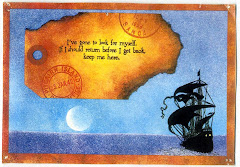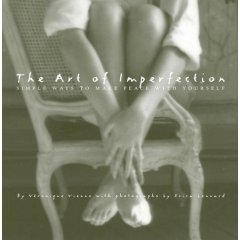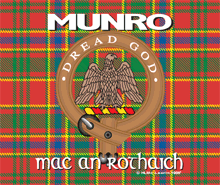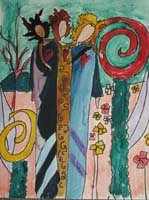"ERIU" by Nicole Cadet
I propose that we rename St. Patrick's Day. Everyone knows the story of St. Patrick driving the snakes out of Ireland. But surprise, surprise, there have never been snakes in Ireland. What Patrick did drive from Ireland were the Celtic goddesses. And gods. The Christian church took away the Celts' ancient religion and forced them to replace it with theirs.
As a Celt, that pisses me off. So let's rename St. Patrick's Day and call it after one of the ancient gods or goddeses of Ireland. There are many to choose from, but Ériu lent her name to the country, so let's make March 17 Ériu's Day.
Ériu (modern Irish Éire) was one of the Tuatha Dé Danann, the god-like inhabitants of pre-Celtic Ireland. With her sisters, Banba and Fódla, she was part of an important triumvirate of goddesses of sovereignty. When the Milesians from Spain defeated the Tuatha Dé Danann each of the three sisters asked that her name be given to the country. This was granted to them. Ériu became the chief name in use, although Banba and Fódla are still sometimes used as poetic names for Ireland.
"BRIGID'S DAWNING" by Michele-lee Phelan
Brigid is one of the primary goddeses of Ireland (later turned into St. Bridget by the Christian church), but I won't write much about her here. I have written several posts devoted solely to her on her day, February 2. Following are eight more of the most popular Celtic gods and goddesses in the pantheon.
"THE DAGDA" by Howard David Johnson
The Dagda (or just Dagda), is the Irish-Celtic god of the earth and treaties, and ruler over life and death. Many talented and powerful, The Dagda is one of the most prominent gods and the chief of the Tuatha Dé Danann. He is a master of magic, a fearsome warrior and a skilled artisan. He was also known as Father of All and The Good God.
The Dagda is portrayed as possessing both super-human strength and appetite. He owned a bottomless cauldron with an inexhaustible supply of food, a magical harp with which he summons the seasons, and an enormous club, with one end of which he could kill nine men, but with the other restore them to life. He also possessed two marvellous swine---one always roasting, the other always growing---and ever-laden fruit trees.
"THE MORRIGAN" by James McPartlin
Sometimes the title The Morrighan - or Morrígu - is used for a trio of war goddesses called Badbh, Macha and Nemain. Confusingly, sometimes The Morrighan is named as one of the three war goddesses, joined with Badba and either Macha or Nemain.
Also called the Queen of the Witches and the Goddess of Magic, The Morrighan is a powerful sorcerer who, it is said, was the inspiration for King Arthur's half sister Morgan LeFay, a sorceress as strong as or even stronger than Merlin.
"MAEVE", Artist Uncredited
Maeve (Medb) was another goddess of war. Where The Morrighan used magic, Maeve wielded a weapon and was a fierce fighter. However, it was also said that the mere sight of Maeve could blind her enemies.
Of the great female figures of Ireland, Maeve was probably the most splendid. Originally a goddess linked with Ireland's mystical center at Tara, Maeve was demoted in mythology to the mere mortal Queen Maeve as the centuries went on and Irish culture changed under Christian influence.
But no mortal queen could have been like this one, this "intoxication" or "drunken woman" (variant meanings of her name), who ran faster than horses, slept with innumerable kings whom she then discarded, and wore live birds and animals across her shoulders and arms. If there ever was an actual woman named Maeve who reigned as Queen of Ireland, it is probable that she was the namesake of the goddess.
Maeve is also known as a goddess of fertility. She was a very lustful woman who needed 30 men a day to ease her sexual appetite. She was a great conqueror and enjoyed enslaving the men of the armies she defeated as spoils of war to pleasure her at will.
"THE MANTLE OF MANANNAN"
by Corina Thornton
Manannán mac Lir is an Irish god of the sea. He was always seen carrying "the Crane Bag", a magical horn of plenty, and he was known to roam among the Celtic tribes in a disguise and aid them in their endeavors.
Manannan mac Lyr was a powerful God, associated with fertility, rebirth, weather, sailing and magic. He is also the Guardian of the Blessed Isles. He often traveled on a magical ship that moved without sails. Sometime he is described as riding over the sea in a chariot. His cloak makes him invisible, his helmet is made of flames and his sword cannot be turned from its mark.
"DANU" by Lisa Hunt
Danu is the oldest Celtic goddess. In Celtic mythology, she was the great mother goddess of the Tuatha Dé Danann (The Tribes of Danu). Few stories about Danu have survived, and yet the reverence in which she was held still remains. Her influence spread far across the British Isles and Europe, where the Danube River was named for her. Danu is a goddess both famous and obscure. Famous, because her name appears in so many place names and texts. Obscure, because no image or narrative of her survives.
Danu, also known as Anu, Dana and Don, is the earth mother, the power that is in the land, never to be overcome by mortals. Danu, which means "swift flowing" in Irish, is the goddess of rivers and wells, and also of prosperity, plenty, magic and wisdom. Depending on the source, she has been called the mother, wife or daughter of The Dagda.
"LUGH", Artist Uncredited
Lugh was a sun god, a young, strong and radiant hero with hair of gold. He was master of all arts, skills and crafts. He was expert in carpentry, masonry, poetry, druidry, medicine and goldsmithing. One day he arrived at the court of The Dagda and demanded to be admitted to the company of the gods. The gatekeeper asked him what powers he possessed that would make him worthy of this honor. For every skill or art Lugh named, the gatekeeper replied that there was already one among the company who had mastered it. Lugh at last pointed out that they had no one who had mastered them all, and so he gained a place among the deities.
He is sometimes called the "Shining One", or "Lugh of the Long Arm". Some accounts say he was the father of the great Irish hero, Cúchulainn.
"NIAMH AND OISIN" by Bojana Dimitrovski
Although Oisín fell in love with Niamh during their time together in Tír na nÓg, he became homesick for the Fianna after what he thought was three years. Niamh let him borrow Embarr, who could run above ground, and made him promise not to get off of the horse or touch Irish soil. The time he had spent in Tír na nÓg turned out to be 300 Irish years. When Oisín returned to Ireland, he found that Fionn mac Cumhail and the Fianna had been long dead and were now only remembered as legends.
Whilst traveling through Ireland, Oisín was asked by some men to help them move a standing stone. He reached down to help them, but fell off his horse. Upon touching the ground he instantly became an old man. He is then said to have dictated his story to Saint Patrick, who cared for and nursed him. Niamh returned to Ireland to search for him, but he had died.
"AINE OF KNOCKAINE" by Helena Nelson-Reed
Aine (anya) is one of the great goddesses of Ireland. Also called Aine Marine and Aine of Knockaine, she was the daughter of King Egobagal, one of the Tuatha De Danann. An extremely popular goddess, Aine has been viewed, at various times, as both a sun goddess and a moon goddess. While she was in her original role as a sun goddess, she was able to shape-shift into becoming “The Red Mare,” the horse that never could be outrun. Traditionally, sun goddesses have been known as goddesses of love and fertility, and Aine followed in that tradition with great enthusiasm.
People would worship Aine in the hope that she might bestow abundance, prosperity and fertility upon them. Aine took her primary responsibility, that of encouraging human sexuality, very seriously. She had a reputation for being exceedingly friendly with human men, and became lovers with many. With them she conceived a lot of children, and by doing so, it is believed that she gave birth to a magickal faerie-human race. She is sometimes known as Queen of the Faeries.
It was during a much later period in time that Aine developed the characteristics of a more maternal moon goddess, and as Goddess of Agriculture, was believed to guard her followers’ livestock and crops.








































16 comments:
I so enjoy your posts...I love history and mystical information...i am also obsessed with all things Irish...please keep up the good work...I really look forward to your posts.
Sheri
Hey Julie - look at it this way. St. Paddy may have driven out the celtic dieties but they are a memory spread now across the world and enjoyed and remembered to this day.
Such research - thanks for the pictures and the information. Great post.
HI JULIE!
Surprise!!! Starting my Pampered Chef business last May has kept me busy. So busy that my blog visits took a hike for awhile. Oh how I have missed visiting my blog friends.
How are you? I see that you are humming along here. Always interesting reading.
Stop by my blog to enter my Harney and Son's "Irish Breakfast Tea" Giveaway. Just post a comment.
Best Blessings, KJ
Another brilliant post Julie with some beautiful artwork. I'd be happy to for March 17th to be known as Eriu's Day!
happy st. patricks day is a wonderful thing to say! it starts off with the word happy and that is what is to be irish! don't bother being pissed! st. pat was not a bad guy and the irish were no fools. pat gave the irish a chance to evolve rather than be destroyed by christians like every other "pagan worshiping" society. the celtic beliefs and traditions were preserved in history and pat convinced the romans to stop taking the irish as prisoners and slaves because they were "good christians" ha! right back at ya' do gooders! you can't make us "good" we're irish! curl up with an irish coffee and read "how the irish saved civilization" you will love it! love your blog! hugs, s.
I totally agree, I definitely would prefer St.Brigid or Goddess Brigid day or any of the other Celtic goddesses... We could even just call it Irish day.
Thanks for a great Post.
Kate
I heard that St. Patrick was from Wales.
I think it is kinda like the Bunnies for Easter, it is a simble...it isn't the story of Easter. My Grandmother was a story teller, she loved to spin a tale, so from my point of view, it is all just stories, we were not there. I think history is a wonderful thing, and that the truth is always best, but a good yarn is fun sometimes.
Think Green! Mary
Whoops....sorry I sent you that St. Patrick's day card in the mail. I was thinking "Ireland"..not so much Patrick.
But I am a Patrick fan.
I have the BEST video on Patrick...he was Welsh I believe actually. And he was enslaved in Ireland for about six years and was made to "Sheep/pig herd"...then was rescued and then went back to them.
Because he loved them.
He didn't have to go.
He really wasn't that terrible of a person. In fact his own denomination hated him and persucuted him in the end.
Then caonized him, years later...go figure.
And I believe the Celts needed him....they were pretty brutal.
The book that Sarah mentioned is one of the BEST books I have read. I did a TON of research before I went to Ireland.
I need to reread it...
"How the Irish SAVED Civilization."
Have you read it before?
Have a great IRISH day Julie...HA!!!
Gosh, Julie...I am always drawn in by the lovely paintings you post here. Each one is exquisite, always. Not to mention a bit of history for inquiring minds!
I love finding this stuff out. Being raised a Catholic the nuns never told us how some of the rituals or holiday got their names.
Since it's nearly here ~ Happy Spring Equinox!
~Hail Aine one of the great goddesses~
a pleasure visually and to read through...namaste Trace x
im with you on this one julie, st Eriu's day it shall be x x great post
The closeness of St. Patrick's Day and Alban Eiler seems to me more than coincidental. I suspect that the Roman Catholic's invented St. Patrick's Day to replace Alban Eiler and they probably intentionally broke the association with the equinox. I don't have any real evidence except that both days where traditionally feast days. Also, in the 5th century (when Patrick was in Ireland) the vernal equinox frequently fell on March 19th, which combined with the use of the older Julian calendar system could account for the missing couple of days.
Anyway, just an idea I've been kicking around for a few years, and it ties in nicely with your last few posts.
I found your blog while looking for fairy "stuff". I love it, and agree completely with your proposal to rename St. Patrick's day! I need to get back to my blogging. I was faithful till I moved to the mountains in November 2008. Thank you for the reminder of its worth.
Post a Comment